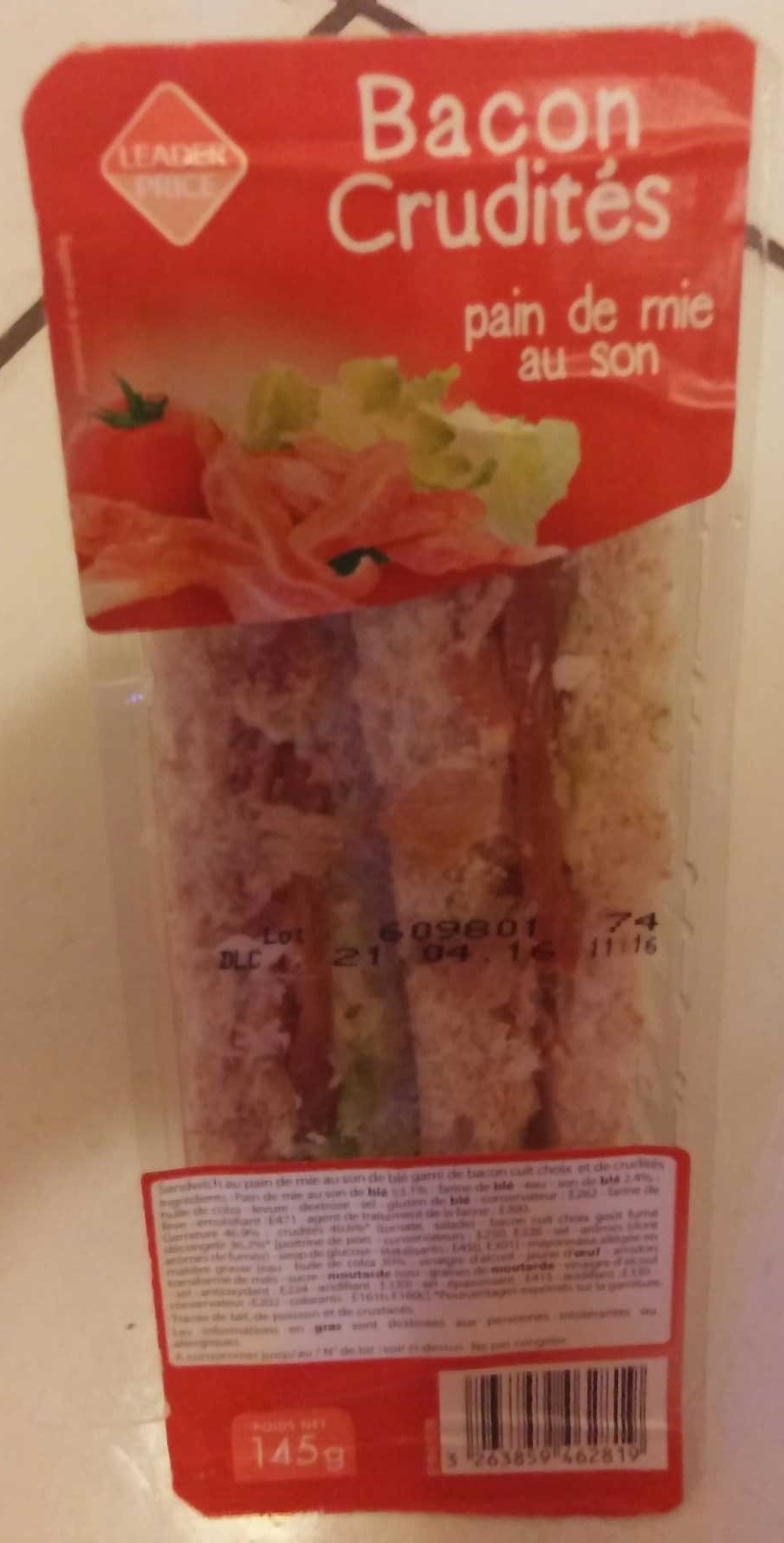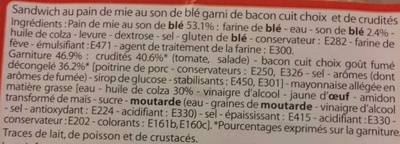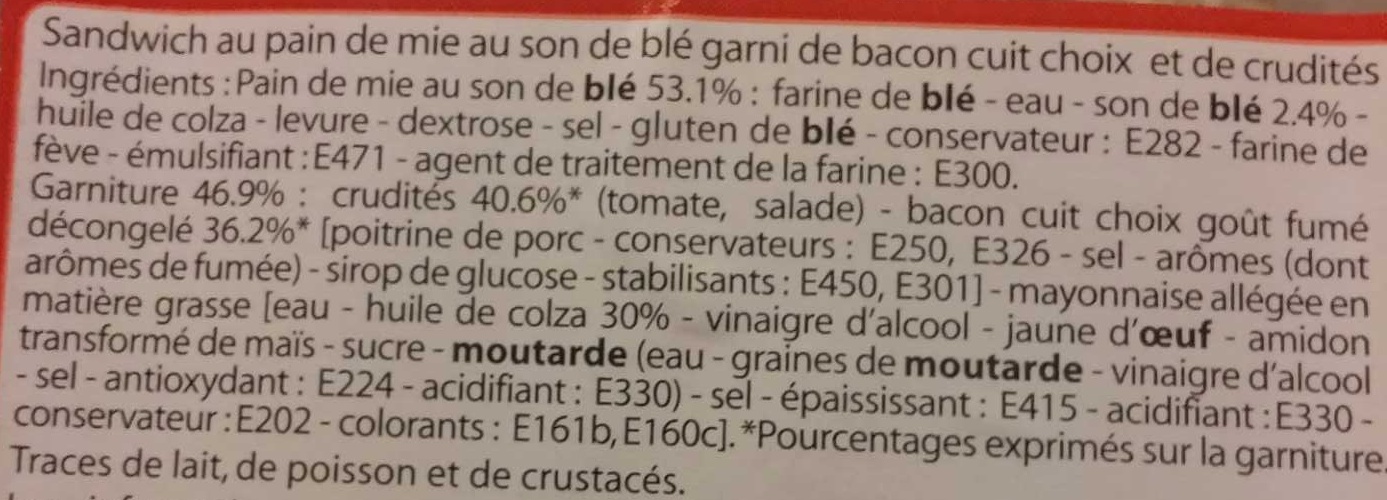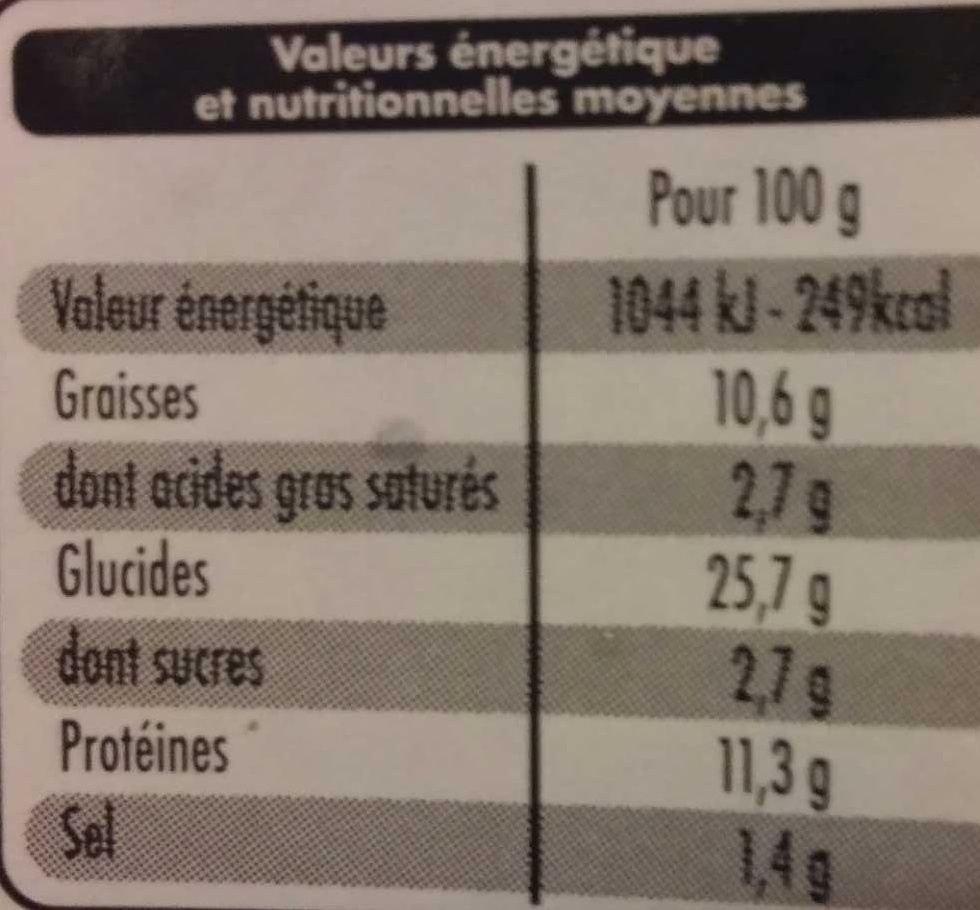Help us make food transparency the norm!
As a non-profit organization, we depend on your donations to continue informing consumers around the world about what they eat.
The food revolution starts with you!
Sandwich Bacon Crudités, Pain de Mie au Son - Leader Price - 145 g
Sandwich Bacon Crudités, Pain de Mie au Son - Leader Price - 145 g
This product page is not complete. You can help to complete it by editing it and adding more data from the photos we have, or by taking more photos using the app for Android or iPhone/iPad. Thank you!
×
Barcode: 3263859462819 (EAN / EAN-13)
Quantity: 145 g
Brands: Leader Price
Categories: Sandwiches, Sandwiches filled with cold cuts, Bacon sandwiches, fr:Sandwich bacon crudités
Labels, certifications, awards:
Green Dot
Traceability code: EMB 01159B - Feillens (Ain, France)
Stores: Leader Price
Countries where sold: France
Matching with your preferences
Health
Ingredients
-
58 ingredients
: Pain de mie au son de blé 53,1% : farine de blé, eau, son de blé 2,4%, huile de colza, levure, dextrose, sel, gluten de blé, conservateur : E282, farine de fève, émulsifiant : E471, agent de traitement de la farine : E300. Garniture 46,9% : crudités 40,6%* (tomate, salade), bacon cuit choix goût fumé décongelé 36,2%* [poitrine de porc, conservateurs : E250, E326, sel, arômes (dont arômes de fumée), sirop de glucose, stabilisants : E450, E301], mayonnaise allégée en matière grasse [eau, huile de colza 30%, vinaigre d'alcool, jaune d'œuf, amidon transformé de maïs, sucre, moutarde (eau, graines de moutarde, vinaigre d'alcool, sel, antioxydant : E224, acidifiant : E330), sel, épaississant : E415, acidifiant : E330, conservateur : E202, colorants : E161b, E160c]. *Pourcentages exprimés sur la garniture.Allergens: Eggs, Gluten, Mustard
Food processing
-
Ultra processed foods
Elements that indicate the product is in the 4 - Ultra processed food and drink products group:
- Additive: E14XX - Modified Starch
- Additive: E160c - Paprika extract
- Additive: E161b - Lutein
- Additive: E326 - Potassium lactate
- Additive: E415 - Xanthan gum
- Additive: E450 - Diphosphates
- Additive: E471 - Mono- and diglycerides of fatty acids
- Ingredient: Colour
- Ingredient: Dextrose
- Ingredient: Emulsifier
- Ingredient: Flavouring
- Ingredient: Glucose
- Ingredient: Glucose syrup
- Ingredient: Gluten
- Ingredient: Thickener
Food products are classified into 4 groups according to their degree of processing:
- Unprocessed or minimally processed foods
- Processed culinary ingredients
- Processed foods
- Ultra processed foods
The determination of the group is based on the category of the product and on the ingredients it contains.
Additives
-
E202 - Potassium sorbate
Potassium sorbate (E202) is a synthetic food preservative commonly used to extend the shelf life of various food products.
It works by inhibiting the growth of molds, yeast, and some bacteria, preventing spoilage. When added to foods, it helps maintain their freshness and quality.
Some studies have shown that when combined with nitrites, potassium sorbate have genotoxic activity in vitro. However, potassium sorbate is generally recognized as safe (GRAS) by regulatory authorities.
-
E224 - Potassium metabisulphite
Potassium metabisulfite: Potassium metabisulfite, K2S2O5, also known as potassium pyrosulfite, is a white crystalline powder with a pungent sulfur odour. The main use for the chemical is as an antioxidant or chemical sterilant. It is a disulfite and is chemically very similar to sodium metabisulfite, with which it is sometimes used interchangeably. Potassium metabisulfite is generally preferred out of the two as it does not contribute sodium to the diet. Potassium metabisulfite has a monoclinic crystal structure which decomposes at 190 °C, yielding potassium sulfite and sulfur dioxide: K2S2O5-s- → K2SO3-s- + SO2-g-Source: Wikipedia
-
E250 - Sodium nitrite
Sodium nitrite: Sodium nitrite is the inorganic compound with the chemical formula NaNO2. It is a white to slightly yellowish crystalline powder that is very soluble in water and is hygroscopic. It is a useful precursor to a variety of organic compounds, such as pharmaceuticals, dyes, and pesticides, but it is probably best known as a food additive to prevent botulism. It is on the World Health Organization's List of Essential Medicines, the most important medications needed in a basic health system.Nitrate or nitrite -ingested- under conditions that result in endogenous nitrosation has been classified as "probably carcinogenic to humans" by International Agency for Research on Cancer -IARC-.Source: Wikipedia
-
E282 - Calcium propionate
Calcium propanoate: Calcium propanoate or calcium propionate has the formula Ca-C2H5COO-2. It is the calcium salt of propanoic acid.Source: Wikipedia
-
E301 - Sodium ascorbate
Sodium ascorbate: Sodium ascorbate is one of a number of mineral salts of ascorbic acid -vitamin C-. The molecular formula of this chemical compound is C6H7NaO6. As the sodium salt of ascorbic acid, it is known as a mineral ascorbate. It has not been demonstrated to be more bioavailable than any other form of vitamin C supplement.Sodium ascorbate normally provides 131 mg of sodium per 1‚000 mg of ascorbic acid -1‚000 mg of sodium ascorbate contains 889 mg of ascorbic acid and 111 mg of sodium-. As a food additive, it has the E number E301 and is used as an antioxidant and an acidity regulator. It is approved for use as a food additive in the EU, USA, and Australia and New Zealand.In in vitro studies, sodium ascorbate has been found to produce cytotoxic effects in various malignant cell lines, which include melanoma cells that are particularly susceptible.Source: Wikipedia
-
E326 - Potassium lactate
Potassium lactate: Potassium lactate is a compound with formula KC3H5O3, or H3C-CHOH-COOK. It is the potassium salt of lactic acid. It is produced by neutralizing lactic acid which is fermented from a sugar source. It has E number "E326". Potassium lactate is a liquid product that is usually 60% solids but is available at up to 78% solids.Potassium lactate is commonly used in meat and poultry products to extend shelf life and increase food safety as it has a broad antimicrobial action and is effective at inhibiting most spoilage and pathogenic bacteria. Potassium lactate is also used as an extinguishing medium in the First Alert Tundra fire extinguishers.Source: Wikipedia
-
E330 - Citric acid
Citric acid is a natural organic acid found in citrus fruits such as lemons, oranges, and limes.
It is widely used in the food industry as a flavor enhancer, acidulant, and preservative due to its tart and refreshing taste.
Citric acid is safe for consumption when used in moderation and is considered a generally recognized as safe (GRAS) food additive by regulatory agencies worldwide.
-
E415 - Xanthan gum
Xanthan gum (E415) is a natural polysaccharide derived from fermented sugars, often used in the food industry as a thickening and stabilizing agent.
This versatile food additive enhances texture and prevents ingredient separation in a wide range of products, including salad dressings, sauces, and gluten-free baked goods.
It is considered safe for consumption even at high intake amounts.
-
E450 - Diphosphates
Diphosphates (E450) are food additives often utilized to modify the texture of products, acting as leavening agents in baking and preventing the coagulation of canned food.
These salts can stabilize whipped cream and are also found in powdered products to maintain their flow properties. They are commonly present in baked goods, processed meats, and soft drinks.
Derived from phosphoric acid, they're part of our daily phosphate intake, which often surpasses recommended levels due to the prevalence of phosphates in processed foods and drinks.
Excessive phosphate consumption is linked to health issues, such as impaired kidney function and weakened bone health. Though diphosphates are generally regarded as safe when consumed within established acceptable daily intakes, it's imperative to monitor overall phosphate consumption to maintain optimal health.
-
E471 - Mono- and diglycerides of fatty acids
Mono- and diglycerides of fatty acids (E471), are food additives commonly used as emulsifiers in various processed foods.
These compounds consist of glycerol molecules linked to one or two fatty acid chains, which help stabilize and blend water and oil-based ingredients. E471 enhances the texture and shelf life of products like margarine, baked goods, and ice cream, ensuring a smooth and consistent texture.
It is generally considered safe for consumption within established regulatory limits.
Ingredients analysis
-
May contain palm oil
Ingredients that may contain palm oil: E471
-
Non-vegan
Non-vegan ingredients: Pork breast, Egg yolkSome ingredients could not be recognized.
We need your help!
You can help us recognize more ingredients and better analyze the list of ingredients for this product and others:
- Edit this product page to correct spelling mistakes in the ingredients list, and/or to remove ingredients in other languages and sentences that are not related to the ingredients.
- Add new entries, synonyms or translations to our multilingual lists of ingredients, ingredient processing methods, and labels.
If you would like to help, join the #ingredients channel on our Slack discussion space and/or learn about ingredients analysis on our wiki. Thank you!
-
Non-vegetarian
Non-vegetarian ingredients: Pork breastSome ingredients could not be recognized.
We need your help!
You can help us recognize more ingredients and better analyze the list of ingredients for this product and others:
- Edit this product page to correct spelling mistakes in the ingredients list, and/or to remove ingredients in other languages and sentences that are not related to the ingredients.
- Add new entries, synonyms or translations to our multilingual lists of ingredients, ingredient processing methods, and labels.
If you would like to help, join the #ingredients channel on our Slack discussion space and/or learn about ingredients analysis on our wiki. Thank you!
-
Details of the analysis of the ingredients
We need your help!
Some ingredients could not be recognized.
We need your help!
You can help us recognize more ingredients and better analyze the list of ingredients for this product and others:
- Edit this product page to correct spelling mistakes in the ingredients list, and/or to remove ingredients in other languages and sentences that are not related to the ingredients.
- Add new entries, synonyms or translations to our multilingual lists of ingredients, ingredient processing methods, and labels.
If you would like to help, join the #ingredients channel on our Slack discussion space and/or learn about ingredients analysis on our wiki. Thank you!
: Pain de mie au son de _blé_ 53.1% (farine de _blé_), eau, son de _blé_ 2.4%, huile de colza, levure, dextrose, sel, gluten de _blé_, conservateur (e282), farine de fève, émulsifiant (e471), agent de traitement de la farine (e300, Garniture 46.9%), crudités 40.6% (tomate, salade), bacon cuit choix goût fumé décongelé 36.2% (poitrine de porc, conservateurs (e250), e326, sel, arômes (dont arômes de fumée), sirop de glucose, stabilisants (e450), e301), mayonnaise allégée en matière grasse (eau, huile de colza 30%, vinaigre d'alcool, jaune d'_œuf_, amidon transformé de maïs, sucre, _moutarde_ (eau, graines de _moutarde_, vinaigre d'alcool, sel, antioxydant (e224), acidifiant (e330)), sel, épaississant (e415), acidifiant (e330), conservateur (e202), colorants (e161b), e160c)- Pain de mie au son de _blé_ -> fr:pain-de-mie-au-son-de-ble - percent: 53.1
- farine de _blé_ -> en:wheat-flour - vegan: yes - vegetarian: yes - ciqual_proxy_food_code: 9410
- eau -> en:water - vegan: yes - vegetarian: yes - ciqual_food_code: 18066
- son de _blé_ -> en:wheat-bran - vegan: yes - vegetarian: yes - ciqual_food_code: 9621 - percent: 2.4
- huile de colza -> en:colza-oil - vegan: yes - vegetarian: yes - from_palm_oil: no - ciqual_food_code: 17130
- levure -> en:yeast - vegan: yes - vegetarian: yes
- dextrose -> en:dextrose - vegan: yes - vegetarian: yes - ciqual_proxy_food_code: 31016
- sel -> en:salt - vegan: yes - vegetarian: yes - ciqual_food_code: 11058
- gluten de _blé_ -> en:wheat-gluten - vegan: yes - vegetarian: yes
- conservateur -> en:preservative
- e282 -> en:e282 - vegan: yes - vegetarian: yes
- farine de fève -> en:broad-bean-flour - vegan: yes - vegetarian: yes - ciqual_proxy_food_code: 9410
- émulsifiant -> en:emulsifier
- e471 -> en:e471 - vegan: maybe - vegetarian: maybe - from_palm_oil: maybe
- agent de traitement de la farine -> en:flour-treatment-agent
- e300 -> en:e300 - vegan: yes - vegetarian: yes
- Garniture -> en:filling - vegan: maybe - vegetarian: maybe - percent: 46.9
- crudités -> en:crudites - vegan: yes - vegetarian: yes - percent: 40.6
- tomate -> en:tomato - vegan: yes - vegetarian: yes - ciqual_food_code: 20047
- salade -> en:salad - vegan: yes - vegetarian: yes
- bacon cuit choix goût fumé décongelé -> fr:bacon-cuit-choix-gout-fume-decongele - percent: 36.2
- poitrine de porc -> en:pork-breast - vegan: no - vegetarian: no - ciqual_proxy_food_code: 28205
- conservateurs -> en:preservative
- e250 -> en:e250 - vegan: yes - vegetarian: yes
- e326 -> en:e326 - vegan: yes - vegetarian: yes
- sel -> en:salt - vegan: yes - vegetarian: yes - ciqual_food_code: 11058
- arômes -> en:flavouring - vegan: maybe - vegetarian: maybe
- dont arômes de fumée -> en:smoke-flavouring - vegan: maybe - vegetarian: maybe
- sirop de glucose -> en:glucose-syrup - vegan: yes - vegetarian: yes - ciqual_proxy_food_code: 31016
- stabilisants -> en:stabiliser
- e450 -> en:e450 - vegan: yes - vegetarian: yes
- e301 -> en:e301 - vegan: yes - vegetarian: yes
- mayonnaise allégée en matière grasse -> en:reduced-fat-mayonnaise - vegan: maybe - vegetarian: maybe - ciqual_food_code: 11079
- eau -> en:water - vegan: yes - vegetarian: yes - ciqual_food_code: 18066
- huile de colza -> en:colza-oil - vegan: yes - vegetarian: yes - from_palm_oil: no - ciqual_food_code: 17130 - percent: 30
- vinaigre d'alcool -> en:alcohol-vinegar - vegan: yes - vegetarian: yes - ciqual_food_code: 11018
- jaune d'_œuf_ -> en:egg-yolk - vegan: no - vegetarian: yes - ciqual_food_code: 22002
- amidon transformé de maïs -> en:modified-corn-starch - vegan: yes - vegetarian: yes - ciqual_food_code: 9510
- sucre -> en:sugar - vegan: yes - vegetarian: yes - ciqual_proxy_food_code: 31016
- _moutarde_ -> en:mustard - ciqual_food_code: 11013
- eau -> en:water - vegan: yes - vegetarian: yes - ciqual_food_code: 18066
- graines de _moutarde_ -> en:mustard-seed - vegan: yes - vegetarian: yes - ciqual_food_code: 11013
- vinaigre d'alcool -> en:alcohol-vinegar - vegan: yes - vegetarian: yes - ciqual_food_code: 11018
- sel -> en:salt - vegan: yes - vegetarian: yes - ciqual_food_code: 11058
- antioxydant -> en:antioxidant
- e224 -> en:e224 - vegan: yes - vegetarian: yes
- acidifiant -> en:acid
- e330 -> en:e330 - vegan: yes - vegetarian: yes
- sel -> en:salt - vegan: yes - vegetarian: yes - ciqual_food_code: 11058
- épaississant -> en:thickener
- e415 -> en:e415 - vegan: yes - vegetarian: yes
- acidifiant -> en:acid
- e330 -> en:e330 - vegan: yes - vegetarian: yes
- conservateur -> en:preservative
- e202 -> en:e202 - vegan: yes - vegetarian: yes
- colorants -> en:colour
- e161b -> en:e161b - vegan: yes - vegetarian: yes
- e160c -> en:e160c - vegan: yes - vegetarian: yes
Nutrition
-
Good nutritional quality
⚠ ️Warning: the amount of fiber is not specified, their possible positive contribution to the grade could not be taken into account.⚠ ️Warning: the amount of fruits, vegetables and nuts is not specified on the label, it was estimated from the list of ingredients: 81This product is not considered a beverage for the calculation of the Nutri-Score.
Positive points: 10
- Proteins: 5 / 5 (value: 11.3, rounded value: 11.3)
- Fiber: 0 / 5 (value: 0, rounded value: 0)
- Fruits, vegetables, nuts, and colza/walnut/olive oils: 5 / 5 (value: 81.125, rounded value: 81.1)
Negative points: 11
- Energy: 3 / 10 (value: 1044, rounded value: 1044)
- Sugars: 0 / 10 (value: 2.7, rounded value: 2.7)
- Saturated fat: 2 / 10 (value: 2.7, rounded value: 2.7)
- Sodium: 6 / 10 (value: 560, rounded value: 560)
The points for proteins are counted because the points for the fruits, vegetables, nuts and colza/walnut/olive oils are at the maximum.
Nutritional score: (11 - 10)
Nutri-Score:
-
Nutrient levels
-
Fat in moderate quantity (10.6%)
What you need to know- A high consumption of fat, especially saturated fats, can raise cholesterol, which increases the risk of heart diseases.
Recommendation: Limit the consumption of fat and saturated fat- Choose products with lower fat and saturated fat content.
-
Saturated fat in moderate quantity (2.7%)
What you need to know- A high consumption of fat, especially saturated fats, can raise cholesterol, which increases the risk of heart diseases.
Recommendation: Limit the consumption of fat and saturated fat- Choose products with lower fat and saturated fat content.
-
Sugars in low quantity (2.7%)
What you need to know- A high consumption of sugar can cause weight gain and tooth decay. It also augments the risk of type 2 diabetes and cardio-vascular diseases.
Recommendation: Limit the consumption of sugar and sugary drinks- Sugary drinks (such as sodas, fruit beverages, and fruit juices and nectars) should be limited as much as possible (no more than 1 glass a day).
- Choose products with lower sugar content and reduce the consumption of products with added sugars.
-
Salt in moderate quantity (1.4%)
What you need to know- A high consumption of salt (or sodium) can cause raised blood pressure, which can increase the risk of heart disease and stroke.
- Many people who have high blood pressure do not know it, as there are often no symptoms.
- Most people consume too much salt (on average 9 to 12 grams per day), around twice the recommended maximum level of intake.
Recommendation: Limit the consumption of salt and salted food- Reduce the quantity of salt used when cooking, and don't salt again at the table.
- Limit the consumption of salty snacks and choose products with lower salt content.
-
-
Nutrition facts
Nutrition facts As sold
for 100 g / 100 mlAs sold
per serving (145 g)Compared to: Bacon sandwiches Energy 1,044 kj
(250 kcal)1,510 kj
(361 kcal)-1% Fat 10.6 g 15.4 g -12% Saturated fat 2.7 g 3.92 g -11% Carbohydrates 25.7 g 37.3 g +8% Sugars 2.7 g 3.92 g -11% Fiber ? ? Proteins 11.3 g 16.4 g +4% Salt 1.4 g 2.03 g +9% Fruits‚ vegetables‚ nuts and rapeseed‚ walnut and olive oils (estimate from ingredients list analysis) 81.125 % 81.125 %
Environment
-
Eco-Score not computed - Unknown environmental impact
We could not compute the Eco-Score of this product as it is missing some data, could you help complete it?Could you add a precise product category so that we can compute the Eco-Score? Add a category
Packaging
-
Packaging with a medium impact
-
Packaging parts
(Plastic)
-
Packaging materials
Material % Packaging weight Packaging weight per 100 g of product Plastic
-
Transportation
-
Origins of ingredients
Missing origins of ingredients information
⚠ ️ The origins of the ingredients of this product are not indicated.
If they are indicated on the packaging, you can modify the product sheet and add them.
If you are the manufacturer of this product, you can send us the information with our free platform for producers.Add the origins of ingredients for this product Add the origins of ingredients for this product
Report a problem
-
Incomplete or incorrect information?
Category, labels, ingredients, allergens, nutritional information, photos etc.
If the information does not match the information on the packaging, please complete or correct it. Open Food Facts is a collaborative database, and every contribution is useful for all.










